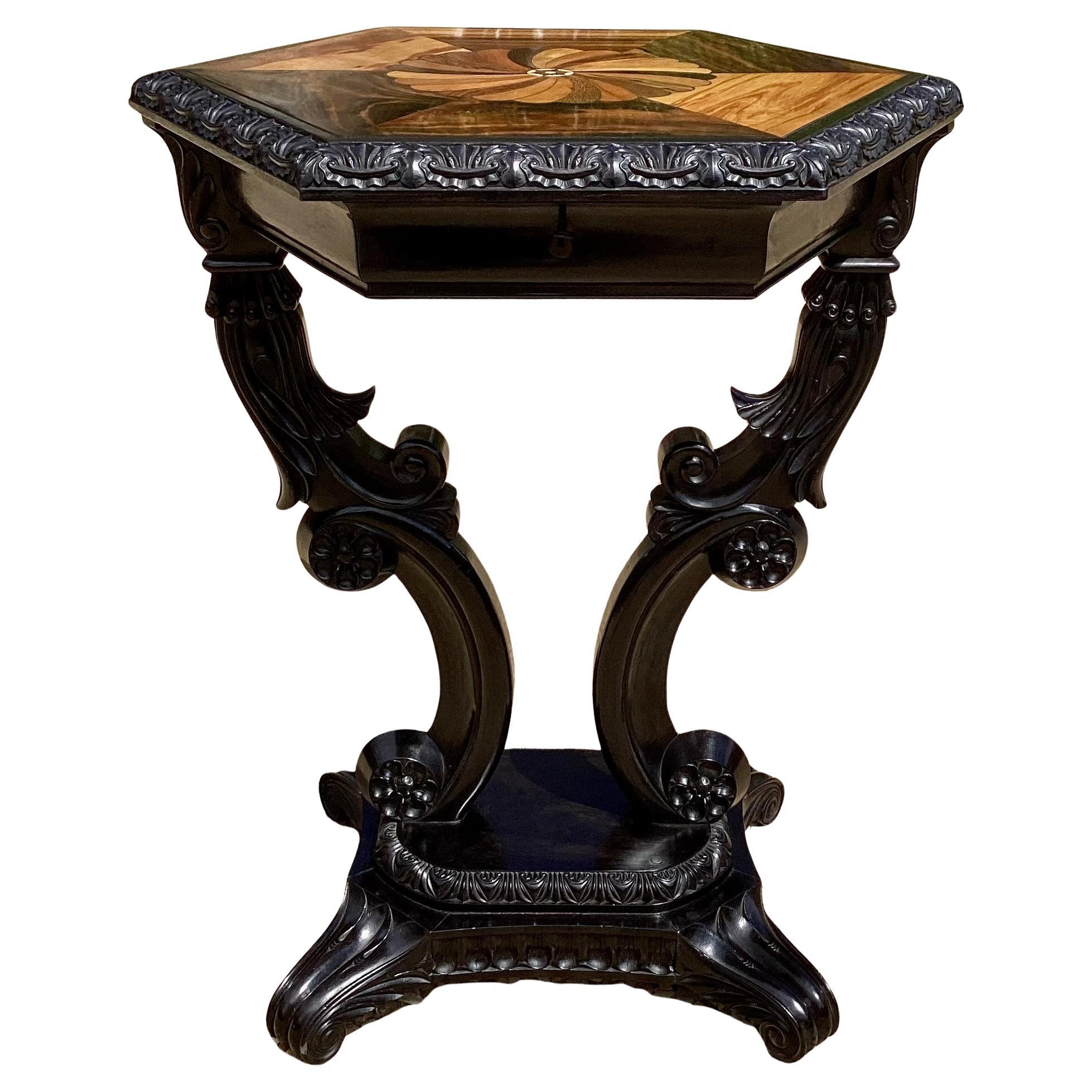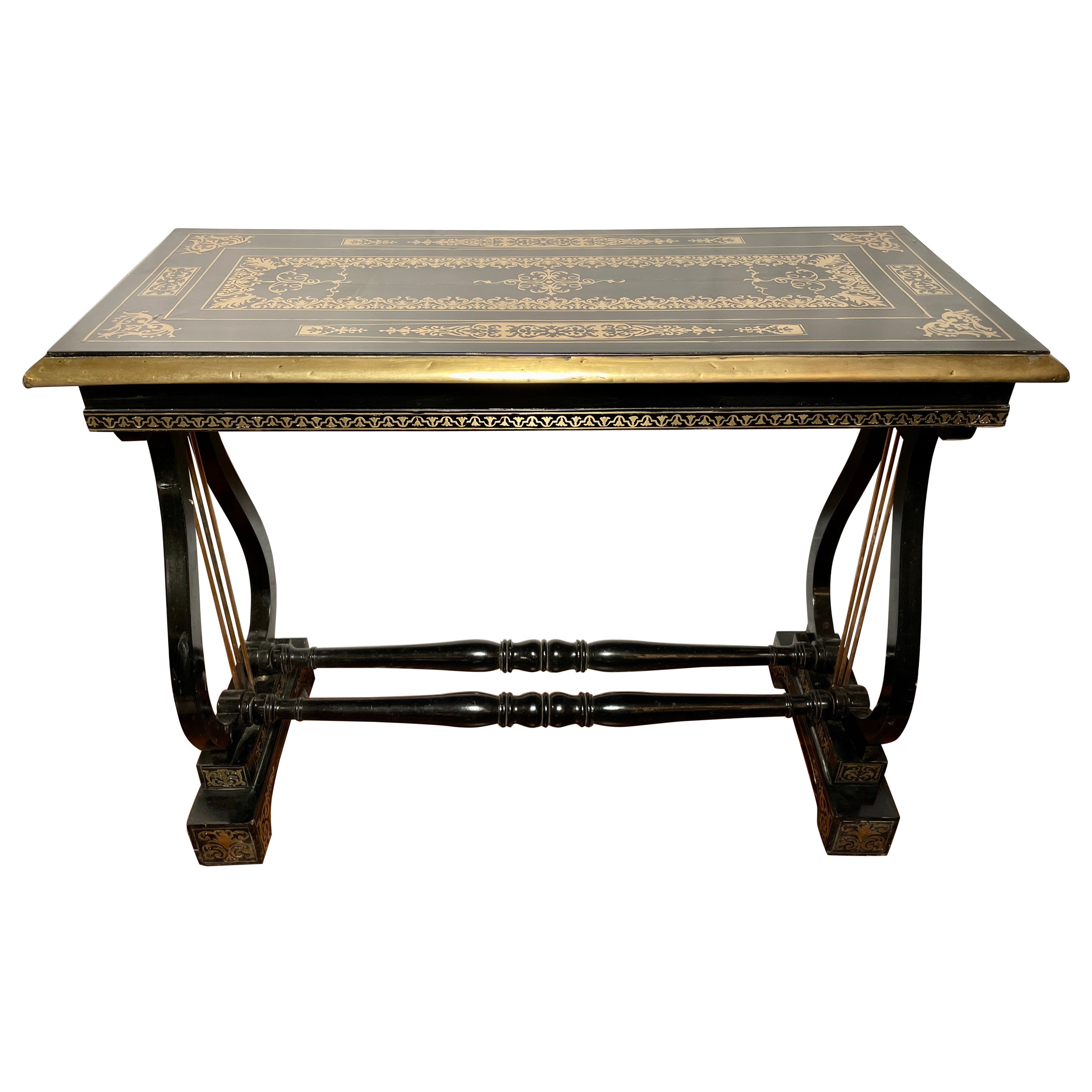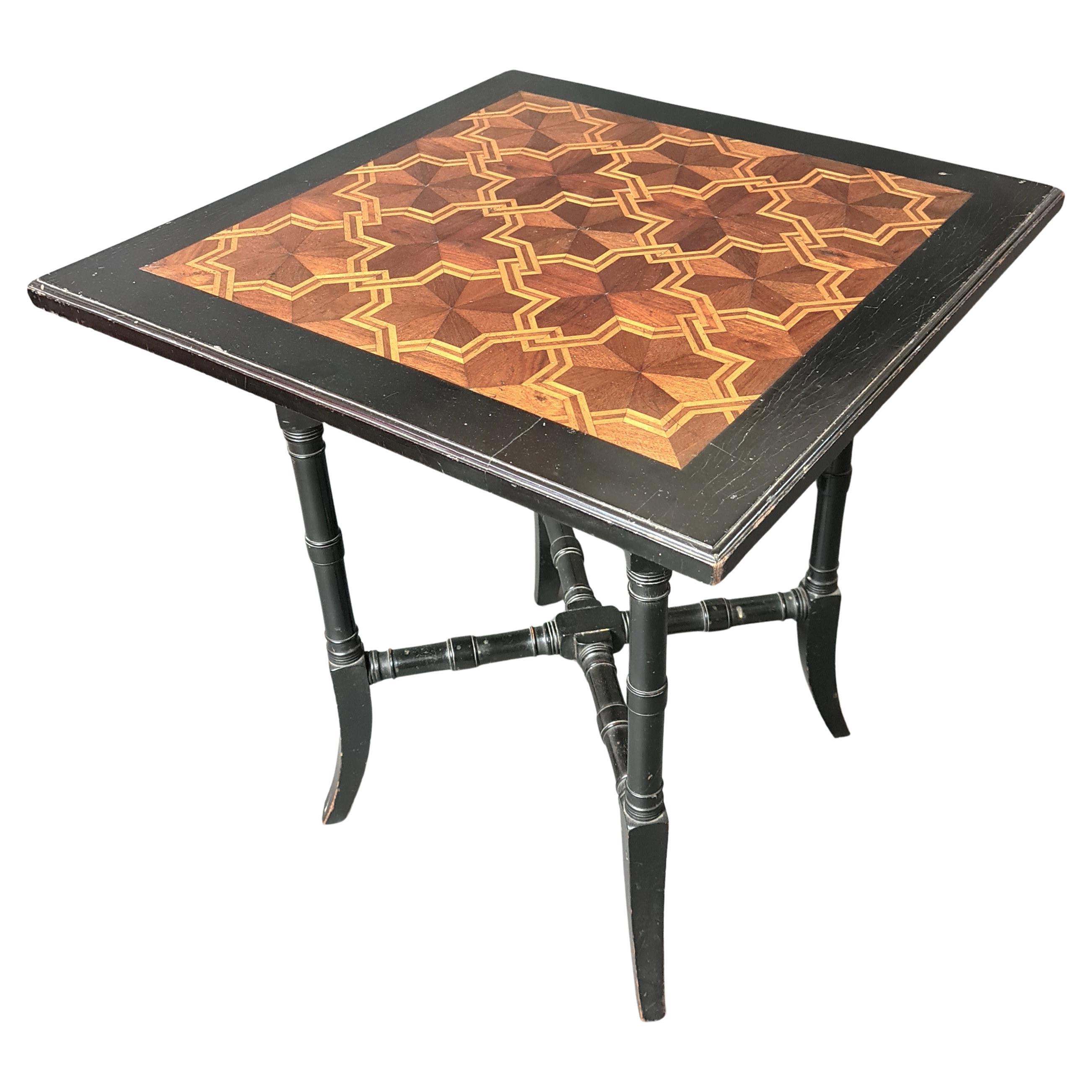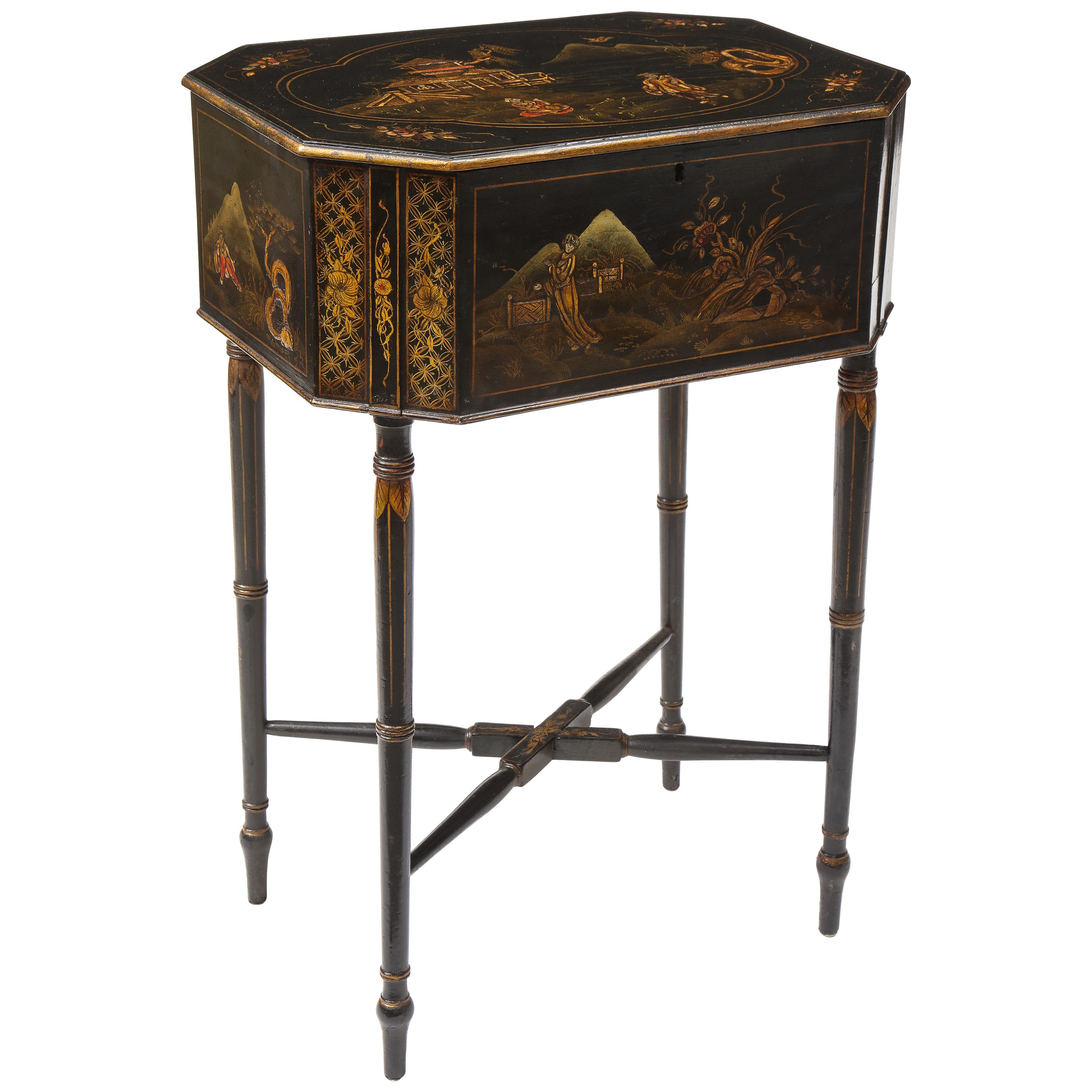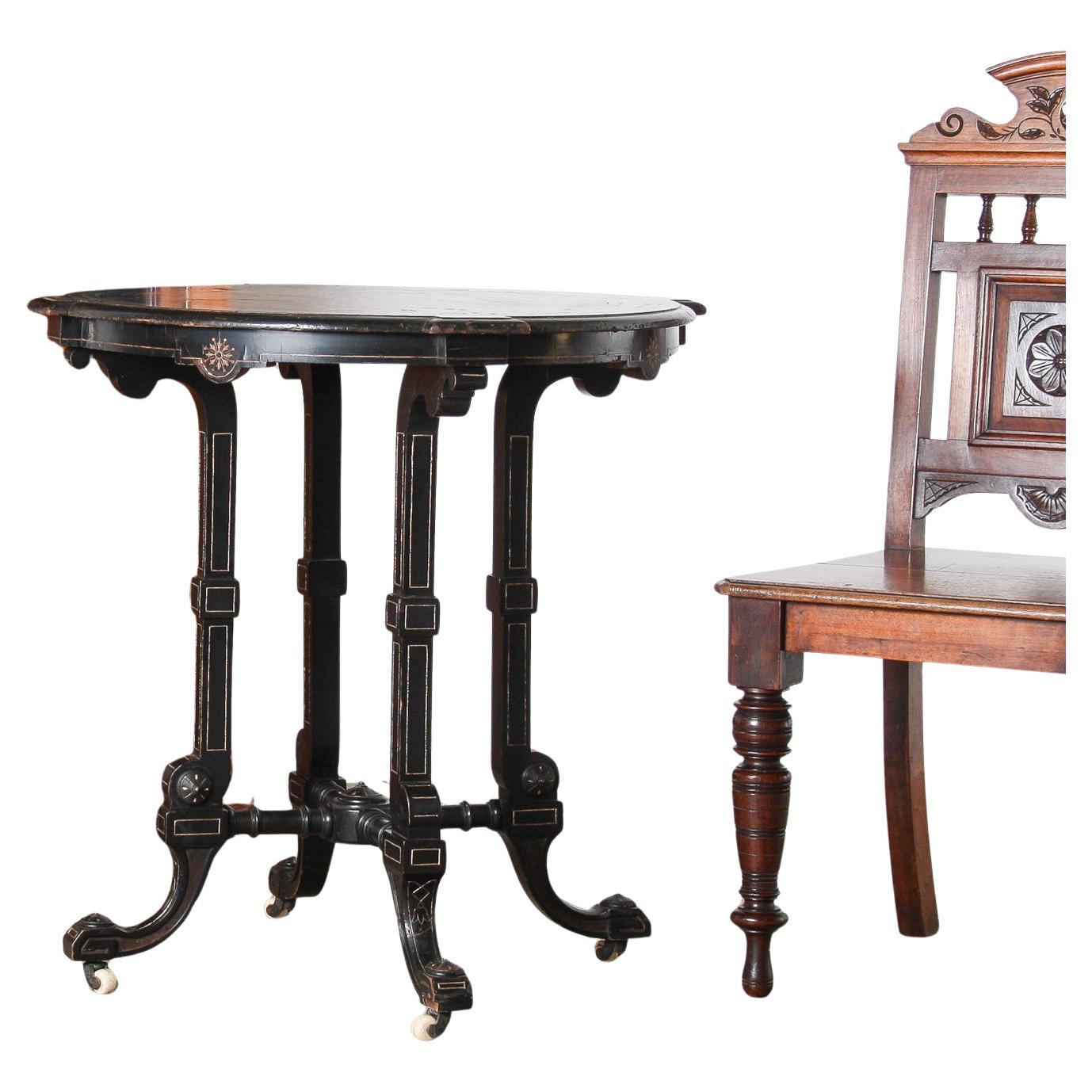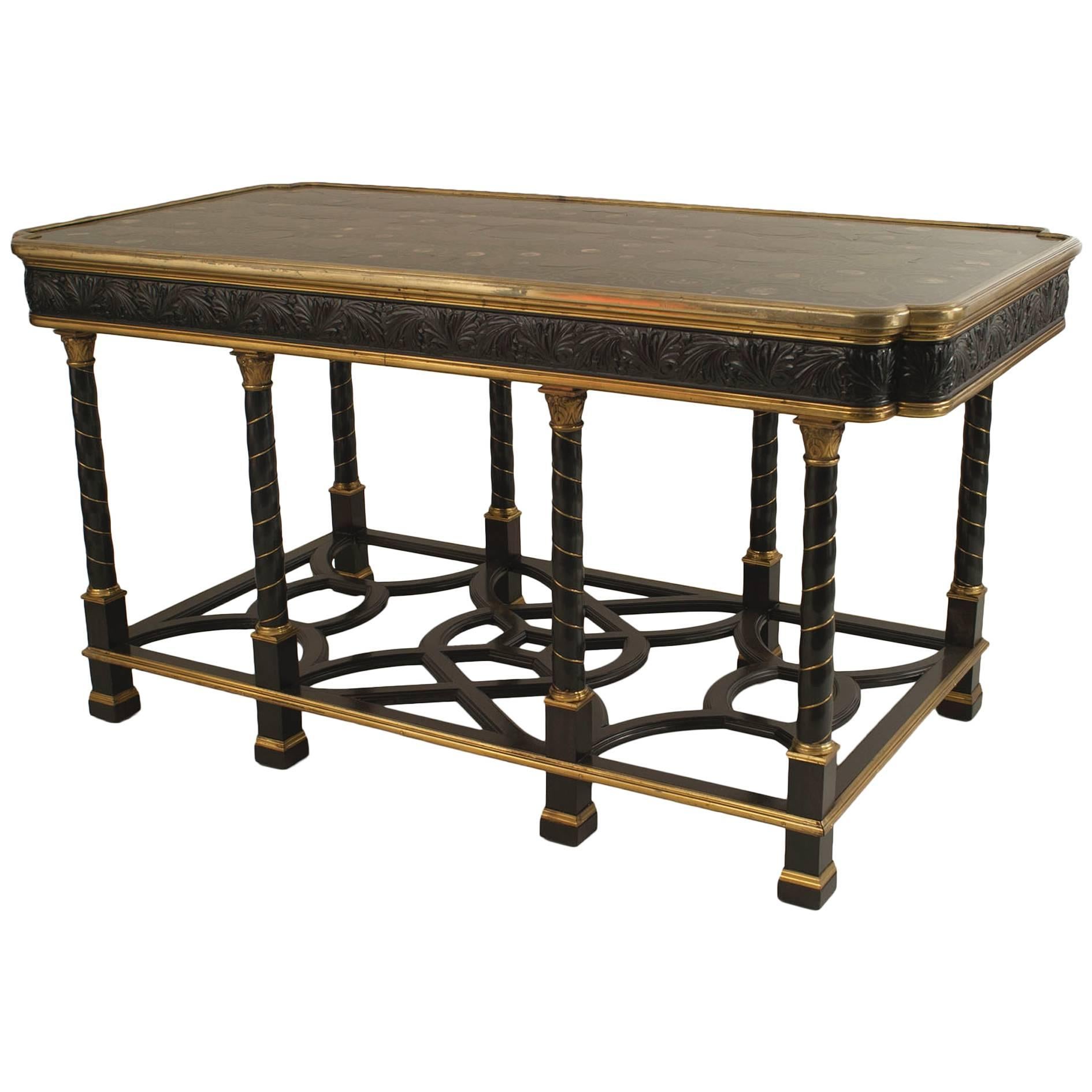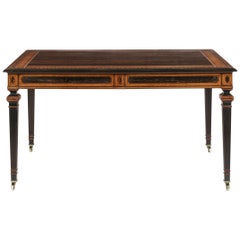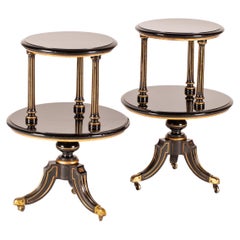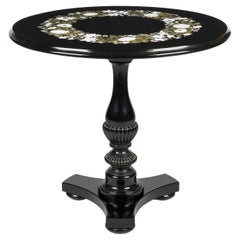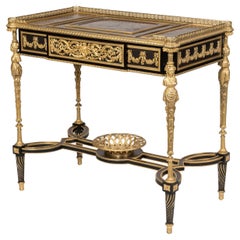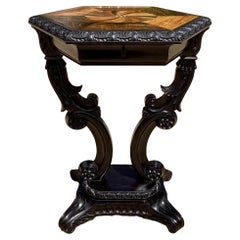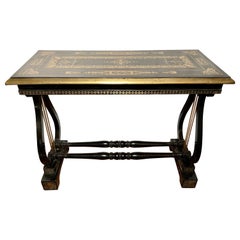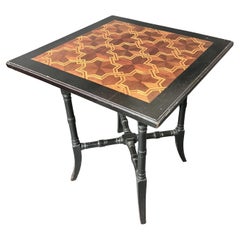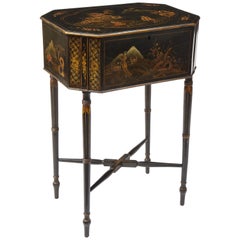Items Similar to 19th Century French Ebonised Table in the Japonisme Style attributed to Viardot
Want more images or videos?
Request additional images or videos from the seller
1 of 8
19th Century French Ebonised Table in the Japonisme Style attributed to Viardot
$14,085.06
£10,500
€12,139.38
CA$19,762.88
A$21,595.04
CHF 11,195.58
MX$257,983.35
NOK 142,470.61
SEK 133,386.26
DKK 90,647.25
About the Item
An Exquisite Ebonised Table
In the Japonisme Manner
Attributed to G. Viardot
Designed in the exotic style associated with the French 'japonisme' movement and the English Aesthetic movement, the table combines ebonised wood with bois satiné, boxwood and brass. The ebonised top inset with a marquetry panel of oriental symbols and motifs, including parchment scrolls, exotic birds, kanji, and a fan, all inlaid within a basketweave parquetry background. The platform top floating on block buffers and a pierced and scrolled frieze, each side set with a brass central plaque. Supported on square section legs transitioning into inverted cabriole forms, joined by an undertier and terminating in claw feet and castors.
French, circa 1880
A number of related tables and carved pedestal signed Viardot are documented, with the same distinct inverted cabriole legs and pierced foliate carving.
Provenance:
Private Collection, UK, acquired from below
H. Blairman & Sons, 2004
Comparative Literature:
Payne, Christopher. Paris Furniture: The Luxury Market of the 19th Century. Château de Saint-Rémy: Éditions Monelle Hayot, 2018, p.541; for a Viardot table with similar brass plaques to the sides.
Dimensions: H: 29 in / 73 cm W: 26 in / 66 cm D: 19.5 in / 49 cm
Gabriel Viardot (1830-1904) was a Parisian cabinetmaker renowned for his furniture creations in the "Chinese-Japanese" style, tailored to European tastes in the late 19th century. Beginning his career as a wood sculptor in 1849, Viardot quickly made a name for himself, running a small team by the age of 19. By 1853, he operated a workshop and furniture store on rue Rambuteau with his brother. In 1860, Viardot established his own atelier, "G. Viardot," and began focusing on East Asian-inspired furniture, evident in his display at the 1867 exposition universelle where he was awarded 4 medals.
His signature style continued to develop throughout the 1870s, characterized by lacquered panels from China or Japan, Tonkin mother-of-pearl inlays, and custom bronze accents, earning him further acclaim, including a silver medal at the 1878 Exposition Universelle. His success continued through the 1880s, with awards at major exhibitions, culminating in a knighthood of the Légion d'honneur in 1885 after the Antwerp Exposition Universelle. At his peak, Viardot's workshop employed 90 to 100 artisans, many of whom he personally trained.
In 1889 and 1900, Viardot received gold medals at the Paris Expositions Universelles, cementing his reputation. His works were made available through prestigious stores such as L'Escalier de Cristal, the famed Parisian emporium, which popularized the Japonisme trend he championed.
- Attributed to:Gabriel Viardot (Cabinetmaker)
- Dimensions:Height: 29 in (73.66 cm)Width: 26 in (66.04 cm)Depth: 19.5 in (49.53 cm)
- Style:Japonisme (Of the Period)
- Materials and Techniques:
- Place of Origin:
- Period:
- Date of Manufacture:circa 1880
- Condition:Wear consistent with age and use.
- Seller Location:London, GB
- Reference Number:Seller: 101391stDibs: LU954743310032
About the Seller
5.0
Recognized Seller
These prestigious sellers are industry leaders and represent the highest echelon for item quality and design.
Established in 1964
1stDibs seller since 2012
54 sales on 1stDibs
Typical response time: <1 hour
Associations
The British Antique Dealers' AssociationLAPADA - The Association of Arts & Antiques Dealers
- ShippingRetrieving quote...Shipping from: London, United Kingdom
- Return Policy
More From This Seller
View All19th Century Coromandel and Inlaid Table Attributed to Jackson & Graham
By Jackson & Graham
Located in London, GB
A magnificent library table
Attributed to Jackson & Graham
Of free standing rectangular form, constructed in coromandel, with inlays in thuya, ebony, boxwood, and honeysuckle; the fluted legs rising from square brass castor-shod feet; the frieze housing two lockable drawers fitted with rare ‘tamper proof’ Chubb locks and having quadrant moulded cedar lined interiors; the platform having a central panel of beautifully chosen matched coromandel veneers, with an outer guard border of a running pattern of stylised anthemions; the ebony edges having a thumb nail moulding,
circa 1865
The firm of Jackson & Graham established in 1836 by Thomas Jackson and Peter Graham at 37 Oxford Street London, and for the next fifty years produced predominately high quality furniture and represented Britain at many of the international exhibitions. Their clients included Queen Victoria, Napoleon III, the Grand Khedive of Cairo and the royal palace in Siam. They were particularly noted for their fine marquetry work, the use of Wedgwood plaques, rare woods, and fine casting of bronze mounts. They engaged the leading designers of the period, inter alia, Owen Jones, Bruce Talbert, Alfred Lorimer and Eugene Prignot. In the mid-1850s the workforce was recorded as 250, and by 1875, the company was employing 600 workers. They were feted exhibitors at many of the Great Exhibitions of the 19th century, and frequent prize winners. At the Paris International Exhibition of 1878, the furniture jury noted of them ‘ the workmanship is so perfect that even with the aid of a magnifying glass scarcely the slightest imperfection is to be found’. In 1885 the company was absorbed by Collinson and Lock, who continued their standard of excellence.
Charles Chubb was apprenticed as a blacksmith before starting business as a ships’ ironmonger in Winchester. Jeremiah soon joined the business, and by 1818 the brothers had branched out into lockmaking, founding the famous Chubb Company.
The business really got started when Jeremiah Chubb patented his new ‘detector lock’ in 1818. The lock was constructed so that if someone tried to pick it or open it with the wrong key it became inoperable. To make the lock work again the owner had to use a special key supplied with the lock. The aim of the detector lock was to prevent burglaries, and to warn the owner that someone had tried to break into their property.
The lock soon became popular, and sales of the Chubbs’ products increased even more when they won a government competition to design a lock that could only be opened using its own key. After the invention of the detector lock, the Chubbs decided to move to Wolverhampton, which already had an established lock making industry. By 1838 they were making 28,000 locks a year at their Wolverhampton factory. Another product was added to the Chubb range in 1835 when a patent was taken out for a burglar resistant safe, and in 1837 the Chubb safe...
Category
Antique 19th Century English Tables
Materials
Brass
Rare 19th Century Pair of Black Lacquered Aesthetic Movement Étagère Tables
Located in London, GB
A pair of black lacquered Étagères
In the early aesthetic Manner
The circular tables having lacquered surfaces with a striking sheen, highlig...
Category
Antique 19th Century English Aesthetic Movement Side Tables
Materials
Wood
19th Century English Black Marble & Hardstone Inlaid Table by Thomas Woodruff
By Thomas Woodruff 1
Located in London, GB
An English Black Marble & Pietra Dura Table
By Thomas Woodruff
'Inlayer to the Queen'
A superb pedestal table of refined proportions and design, constructed entirely from black Ash...
Category
Antique 19th Century English Tables
Materials
Marble
19th Century French Louis XVI Style Table by Henry Dasson with Lacquer Panels
By Henry Dasson
Located in London, GB
- Exquisite Louis XVI style table by renowned maker Henry Dasson, inspired by Marie-Antoinette's furniture
- Stunning Asian lacquer panels featuring mythological deer motifs
- Exce...
Category
Antique 19th Century French Louis XVI Center Tables
Materials
Ormolu
19th Century Marble-Top Lacquer Table in the Louis XVI Style by Henry Dasson
By Henry Dasson
Located in London, GB
Of rectangular form, constructed in amboyna and mahogany dressed with chinoiserie lacquer panels, and fine ormolu mounts; rising from ormolu mounted toupie feet, supporting the lower...
Category
Antique 19th Century French Louis XVI Side Tables
Materials
Marble, Ormolu
19th Century Marquetry Writing Table in the manner of Holland & Sons
Located in London, GB
A good writing table in the Manner of Holland & Sons
Constructed in mahogany, with specimen wood inlays, and gilt bronze mounts; of rectangular form, with bowed ends, rising from ri...
Category
Antique 19th Century British Victorian Desks and Writing Tables
Materials
Ormolu, Bronze
You May Also Like
19th Century Anglo Indian Ebony Occasional Table
Located in Shipston-On-Stour, GB
A smart early C19th Ceylonese Ebony occasional table, the specimen inlaid hexagonal top centred by a swirl of exotic woods including Palm, Satinwood, Coromandel and Palisander. With ...
Category
Vintage 1930s Sri Lankan British Colonial End Tables
Materials
Ebony, Sandalwood, Satinwood, Palmwood
Antique English Regency Inlaid Ebonized Wood Table, Circa 1890
Located in New Orleans, LA
Antique English Regency Inlaid ebonized wood table, circa 1890.
Category
Antique 19th Century English Regency Side Tables
Materials
Wood
Aesthetic Movement ebonised table with parquetry top
Located in Tunbridge Wells, GB
Aesthetic Movement ebonised table with decorative parquetry top in contrasting woods. This table dates to around 1880 the maker is unknown but it is good quality, it could possibly ...
Category
Antique Late 19th Century British Aesthetic Movement Tables
Materials
Mahogany
19th Century English Black Japanned Work Table
Located in New York, NY
With gilt chinoiserie decoration of court figures in a mountainous landscape on a black ground; the hinged rectangular top with canted corner opening to a paper-lined interior; raise...
Category
Antique Mid-18th Century English Sheraton End Tables
Materials
Wood
Antique 19th Century Aesthetic Movement Ebonised Side Table or Window Table
By Gillows of Lancaster & London
Located in Llanbrynmair, GB
An exceptional Antique 19th Century Aesthetic Movement Ebonised Side Table, a superb example of craftsmanship that embodies the elegance of the era. This exquisite piece, possibly cr...
Category
Antique Mid-19th Century English Aesthetic Movement Side Tables
Materials
Beech, Amboyna
$1,808 Sale Price
20% Off
French Victorian Ebony Inlaid Center Table
Located in Queens, NY
French Victorian (19/20th Century) ebony and bronze rectangular center table with 8 swirl design legs connected with an open geometric design stretcher and a top inlaid with pearl & ...
Category
Antique Mid-19th Century French Napoleon III Center Tables
Materials
Brass, Bronze
More Ways To Browse
Oriental Panels
Japanese Pearl Inlay
Wood Carving With Silver Inlay
Antique Chinese Mother Of Pearl Inlay Table
Antique Chinese Pearl Inlay Tables Inlay Tables
Antique Chinese Mother Of Pearl Inlaid Table
G Viardot
Country Arts And Craft
Dragon Stone
Elephant Kitchen
Este Italy
Finch Birds
Fleet Furniture
Form Of A Book
Frederick Prince
French Cast Iron And Marble Bistro Table
Frosted Glass Mirror
Glass Buddha
